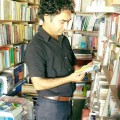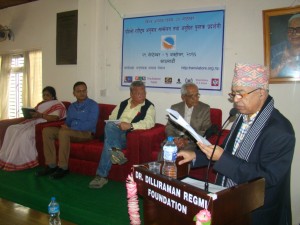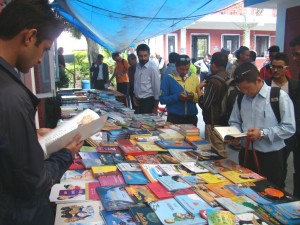
Society of Translators Nepal has recently organized the first ever translation conference in Nepal. The conference served as a forum for translators, researchers, linguists and translation enthusiasts to share their knowledge, experiences and construct new knowledge. The conference also explored the issue of the use of translation in ELT. Although translation method has been severely criticized in ELT pedagogy, the latest approaches and methods entertain judicious use of translation. In this context, Choutari editor Jeevan Karki has spoken to Bal Ram Adhikari (Vice- president of the Society, Translator and Faculty, Department of English, TU) to explore more about translation, the conference and translation in ELT.
Q: Welcome to ELT Choutari! What are you doing these days?
Thank you for this sharing opportunity! Apart from writing essays in Nepali, I’m busy in different translation projects. I’m giving the final touch to Nepali Anubad Sahitya-ko Itihas (History of Nepali Translation Literature), a research-based book to be published from Jagadamba Prakashan. A Grammar of Contemporary Nepali is ready for the press, which is going to be published from Nepal Academy. I’ve just finished the translation and editing of sixteen English short stories into Nepali. I’m also fine-tuning my previous research report Anubad Siddhanta (Translation Theories) for Nepal Academy.
Q: When you look back, how long is the history of translation in Nepal and what is the scope of translation in Nepal?
Let’s look at the first part of your question— History. Nepalese translation has a short history with a long tradition. Tradition is what we do and history is the documentation of what we have done so far.
As a tradition, the translation activity in Nepal is as old as the languages like Nepali, Newari and Maithili. Translation has remained an integral part of this multilingual landscape. Documentation of this age-old activity has begun now. Translation in Nepal is believed to be more than 850 years old. However, the early translation was confined to such writings as royal inscriptions, and records of donations and deeds. To talk of literary translation, it is believed to have begun with the translation of Shakti Ballav Arjyal’s translation of Mahabharat Virat Parva in 1771 from Sanskrit. In my research, I have divided the duration of eight and a half century into four periods, namely the early period, the developmental period, the modern period and the contemporary age.
As to English-Nepali translation, it’s almost a century-old phenomenon. Nepali-English translation, on the other hand, has only crossed five decades. Shyam Das Vaisnav’s collection of poems Upahar is the first Nepali literary writing to be translated into English. Laxmi Prasad Devkota translated it under the Present in 1963.
Now, let’s turn to the second part of your question— its scope. Translation is growing as a widening gyre in Nepal. Academically, all Nepalese universities have recognized it as a distinct discipline. Literature, linguistics and language education departments have a separate course on translation in their master’s programmes. In practice, translation has been lifeblood of all forms of news media. Now the success or failure of our multilingual information marketplace depends largely on our ability to translate into and from the dominant languages like English. Similarly, publishing houses in Nepal are heavily relying on the translation business. Look at the books translated from English and Hindi floating in the book bazaar. Professionally, some daring bilinguals are coming to the front, who proudly call themselves translators. It indicates that translation in Nepal is moving in the direction of professionalism. There is also an organization of translators ‘Society of Translators Nepal’. Similarly, Nepal Academy has established a separate department of translation.
 Q: It sounds encouraging. Let’s relate this to the recent fervour created by the Society of Translators Nepal. Last month, the Society organized the first ever conference on translation in Nepal. What was the aim of it and how do you evaluate the conference?
Q: It sounds encouraging. Let’s relate this to the recent fervour created by the Society of Translators Nepal. Last month, the Society organized the first ever conference on translation in Nepal. What was the aim of it and how do you evaluate the conference?
The Society organized a two-day conference and a three-day exhibition of translated books. It was our effort to put our motto into action: Sharing, Caring and Daring in Translation. That is to say, the aim of the conference was to create a platform where translators, translation researchers, theorists, and translation enthusiasts could come and share their experiences, practical insights and theoretical information. This is what happened in the conference. They came. They shared their experiences and insights. They cared each others’ views. They dared to admit their own limitations and weaknesses as translators.
Success! This conference has created academic and professional discourse on translation in Nepal. We translators are in a position to claim our academic and professional visibility. We had 18 paper presenters and more than 100 participants, including professors and university students. One of the goals was to bridge the gap between translation academicians and translation practitioners. I think we have been successful to some extent achieving this goal.
Q: What is the role of translation (process) in the language development of an individual?
It’s an issue under the perpetual debate. Translation is a bilingual process- a mental process which connects one language with the other. Such a connection can take place at different levels of languages ranging from words through sentences to discourse and pragmatics. Now let’s turn to the second part i.e. language development, which implies the growth of an individual’s verbal and syntactic repertoire, and their contextual use. The question is– how does translation contribute to an individual’s language development?
The role of translation in language learning is always positive! Sure enough! But the condition is its cautious handling. It should be used as a technique of teaching and learning a second language rather than as a method. In the past translation as a method was overused. As a result its impact on language development was negative.
The impact of translation on a person’s language development can be explicit as well as implicit. We can see its explicit impact on learning vocabulary. It is direct. The use of a bilingual word list to expand word power in the second language is pervasive. So is case in learning grammar structures. However, in the case of language skills, its role is not as dominant as in learning vocabulary and grammar. Its impact is implicit. Moreover, we should not confine translation only to word-to-word and sentence-to-sentence rendering. It’s also the mental transfer of first language awareness to second language learning. Mental translation is always at work in the mind of a second language learner. From our own experiences, we second language learners can tell how valuable translation has been in our overall language learning process.
The translator is in direct encounter with two languages at the same time. The translator enters not only into the mechanism of language but also experiences its inner spirit. From my own experience as a translator, I can say that it is probably the best way of developing language sensitivity and sensibility.
A communication crisis is another important factor that pushes our language ahead. During the work, translators find themselves in a communication crisis. The crisis is that they always struggle for words, expressions and structures while communicating the source writer’s message to the audience of a different language. They become untiring researchers in search of proper expressions. They are in the choiceless situation- they have no choice but to find out expressions in the target language to communicate with their readers. They often come face-to-face with their own ignorance i.e. limited knowledge of language. The very realization of ignorance forces them to read more, write more and contemplate more. This ultimately develops their language knowledge, and reading and writing skills both. .
Q: What is the state of translation in second language pedagogy, ELT in particular?
Translation is a reality of the second language teaching. Translation is not something from outside that we are imposing on second language learners. In the context like ours where English is being learned as an additional language, we cannot skip translation. Our learning setting is bi-/multilingual; our students are aspiring bilinguals in English; English teachers are bilinguals; the goal of teaching English itself is to make our students bilingual in English. And translation, be it textual or mental, is a route along which our students and teachers shuttle back and forth between their mother tongue and English. I think, to negate translation and advocate monolingual practice (i.e. English-only) is to negate all these bilingual realities.
Contemporary second language theories and practitioners are awakened to such realities. Most of the second language teaching approaches and methods have recognized the intrinsic value of translation in language teaching and learning. However, by this I am not saying Grammar Translation Method has made its comeback to second language pedagogy. Here my focus is on translation as one of the several techniques of language teaching and learning.
Let’s name some of the teaching methods that candidly cherish translation as a teaching technique. Communicative Language Teaching is one of them. In the early 1970s, CLT gave space for the judicious use of the mother tongue in the second language classroom. Other contemporary methods, namely Task-based Language Teaching, Participatory Approach, and Content-based Instruction all have regarded translation as a technique that can be used in different stages of a lesson with the varying degrees of intensity for various purposes. It means the question is not whether to use translation or not but how to use translation for effective teaching.
At this point I am reminded of David Graddol’s book English Next. In the book Graddol has clearly stated that translation and interpretation are two dominant skills to be developed in users of Global English. Its implication is that translation is not only the means, it is also being one of the goals of English Language Education.
But I am disappointed to see how translation is perceived, treated and used in our context. English teachers, educators and trainers are still oblivious to the changing perspectives towards translation. In private schools translation is still a taboo as it was in the early and mid 20th century. They are practicing their ignorance. They are swayed by the fallacy that the use of the mother tongue and translation hamper the learning of English. On the other hand, in the public schools, translation is either overused or wrongly used.
I hope that English teachers trained in the contemporary language teaching methods will find respectful space for translation in the days to come and will use it in a balanced way.
 Q: The quantity of translated books (both in English and Nepali) is increasing in Nepal. How is their quality?
Q: The quantity of translated books (both in English and Nepali) is increasing in Nepal. How is their quality?
It’s good to see the increasing number of translated books in the market. It’s not only the books, with the books is increasing the transfer of ideas and literary crafts across the languages. With the transfer is increasing cross-cultural awareness. Also with the growth of translation is expanding our publishing industry and translation is on the way to becoming a profession. However the worry is that quantity is waxing and quality is waning. Obviously, when there is a race for quantity, quality is often left behind. Most of the translations are poor in quality i.e. clumsy and stilted language, misinterpretation of the source text and its distorted presentation. But we should not forget that some translations are exemplary. I hope such translations will inspire the new translators.
Q: Whose role is it to ensure the quality of translated literature and other materials? What is the role of Society of Translators Nepal to improve their quality?
It’s the translator who becomes the target of criticism when the text fails to come up to certain standards. Undoubtedly, quality is subject to translator’s art and skills, sincerity and sensibility. It means the translator’s role is the key to good translation. However, there are a myriad of other factors at play in translation. First, we should understand that translation is not everyone’s cup of tea. There is a widespread misconception that any good bilingual can be a good translator. Translation is a distinct area of creative writing which calls for rigorous practice, study and training. Moreover, policy and investment of the publishing houses are of paramount importance. Most of the publishers offer a meagre amount to the translator. Even worse, they make no provision for editing. Likewise, the readers’ role also cannot be overlooked. Quality conscious readers can contribute to the publishing of good translations.
Society of Translators Nepal is not the organization to make a direct intervention in quality enhancement. All it can do and has been doing is raise awareness of translation through informal interactions, talks and seminars, and conferences. We invite translators to our talk programme to share their experiences. We have been organizing a seminar to mark the International Translation Day on 30th September. This year we organized the first national conference.
Q: What are the further plans of the Society?
Apart from the annual conference, the Society (http://translators.org.np/) is going to publish its first journal within a couple of months. We are midway through editing of A Bilingual Glossary of Terms. Similarly, we have planned to run some small-scale translation workshops.
Q: What do say to the budding translators and the translation enthusiasts?
First and foremost, we should understand that translation is a distinct field of study and practice. It has its own charms and challenges. No suggestion works unless we sit down and translate. When we start translating, our own experience will guide us. What I say is that those who do not love language should not come to this field. Fall in love with language; be the explorer of meanings; be ready to be an unsatiated leaner of language; be ready to fail and learn from your own failure. Be a voracious reader and be an everyday writer. Be the part of the shangha of translators. Share your experiences and listen to others. Translate something every day.
***